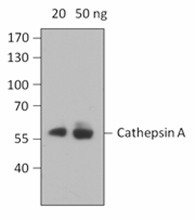- Clone
- 15D2C93 (See other available formats)
- Regulatory Status
- RUO
- Other Names
- CTSA, GSL, Protective Protein For Beta-Galactosidase (PPGB), GLB2, NGBE, Protective Protein Cathepsin A (PPCA), Carboxypeptidase C, Lysosomal Protective Protein, Lysosomal Carboxypeptidase A, Carboxypeptidase-L
- Isotype
- Mouse IgG1, κ
- Ave. Rating
- Submit a Review
- Product Citations
- publications

-

20 or 50 ng of human Cathepsin A recombinant protein was resolved by electrophoresis, transferred to nitrocellulose, and probed with purified monoclonal anti-Cathepsin A (clone 15D2C93) antibody. Proteins were visualized using an HRP Goat anti-mouse IgG Antibody and chemiluminescence detection.
| Cat # | Size | Price | Quantity Check Availability | Save | ||
|---|---|---|---|---|---|---|
| 683902 | 100 µg | 265 CHF | ||||
Cathepsin A, also known as Protective Protein Cathepsin A (PPCA), is a serine carboxypeptidase that is required for correct lysosomal transportation. Cathepsin A is synthesized as a 54 kD zymogen and is processed into an enzymatically active two-chain form in lysosomes. Cathepsin A exhibits carboxypeptidase activity at acidic pH in the lysosome and acts such as deaminase and esterase at a neutral pH. It participates in the inactivation of several selected neuropeptides, which includes substance P, oxytocin, and endothelin I. Cathepsin A forms a multienzyme complex with β-galactosidase (GLB1) and neuraminidase (NEU1). It is necessary for the stability and activity for these two enzymes. Genetic defects in the CTSA gene lead to the secondary combined deficiency of GLB1 and NEU1 and cause the lysosomal storage disease galactosialidosis (GS). Cathepsin A has also been suggested to regulate chaperone-mediated autophagy through the proteolytic inactivation of Lysosome-associated membrane protein 2 (LAMP2).
Product DetailsProduct Details
- Verified Reactivity
- Human
- Antibody Type
- Monoclonal
- Host Species
- Mouse
- Immunogen
- Partial Cathepsin A recombinant protein (29 - 480 a.a.) expressed in 293E cells.
- Formulation
- Phosphate-buffered solution, pH 7.2, containing 0.09% sodium azide.
- Preparation
- The antibody was purified by affinity chromatography.
- Concentration
- 0.5 mg/ml
- Storage & Handling
- The antibody solution should be stored undiluted between 2°C and 8°C.
- Application
-
WB - Quality tested
- Recommended Usage
-
Each lot of this antibody is quality control tested by Western blotting. For Western blotting, the suggested use of this reagent is 0.5 - 2.5 µg per ml. It is recommended that the reagent be titrated for optimal performance for each application.
- RRID
-
AB_2572060 (BioLegend Cat. No. 683902)
Antigen Details
- Structure
- 480 amino acids with a predicted molecular weight of 54.5 kD. Processed active form of Cathepsin A contains a 32 kD chain and a 20 kD chain. These chains form a disulfide-linked heterodimer.
- Distribution
- Lysosome.
- Function
- Cathepsin A is a serine carboxypeptidase required for the activation and stabilization of β-galactosidase and neuraminidase in the lysosomal compartment. Defects in the gene can cause the lysosomal storage disorder galactosialidosis.
- Interaction
- Cathepsin A interacts with CTNNBIP1, GABARAP, ELN, and VAPA.
- Biology Area
- Cell Biology, Neurodegeneration, Neuroscience, Neuroscience Cell Markers, Protein Trafficking and Clearance
- Molecular Family
- Enzymes and Regulators, Lysosomal Markers
- Antigen References
-
1. Kolli N, et al. 2014. J. Biol. Chem. 189:11592.
2. Takiguchi K, et al. 2000. J. Hum. Genet. 45:200.
3. Hahn CN, et al. 1998. Proc. Natl. Acad. Sci. USA 95:14880.
4. van der Spoel A, et al. 1998. EMBO J. 17:1588.
5. Rudenko G, et al. 1998. Proc. Natl. Acad. Sci. USA 95:621.
6. Galjart NJ, et al. 1991. J. Biol. Chem. 266:14754. - Gene ID
- 5476 View all products for this Gene ID
- UniProt
- View information about Cathepsin A on UniProt.org
Related Pages & Pathways
Pages
Other Formats
View All Cathepsin A Reagents Request Custom Conjugation| Description | Clone | Applications |
|---|---|---|
| Purified anti-Cathepsin A | 15D2C93 | WB |
Compare Data Across All Formats
This data display is provided for general comparisons between formats.
Your actual data may vary due to variations in samples, target cells, instruments and their settings, staining conditions, and other factors.
If you need assistance with selecting the best format contact our expert technical support team.
-
Purified anti-Cathepsin A

20 or 50 ng of human Cathepsin A recombinant protein was res...
 Login / Register
Login / Register 







Follow Us